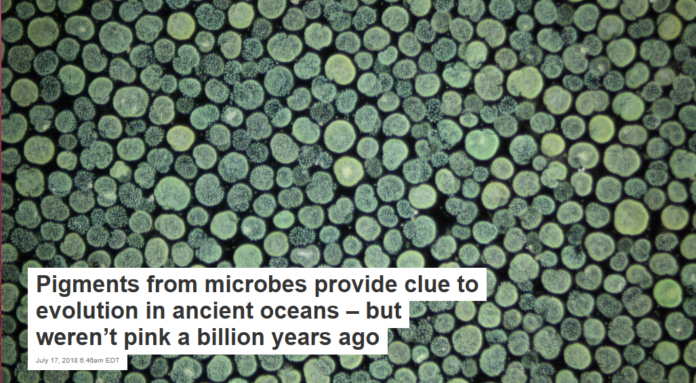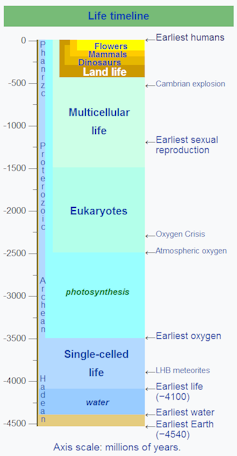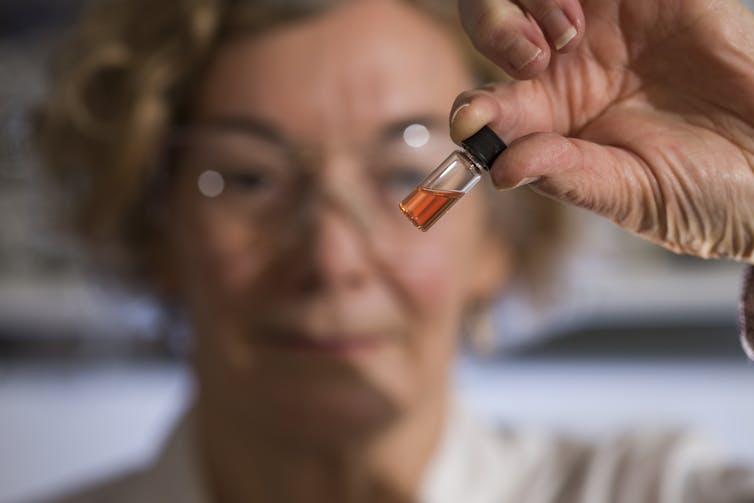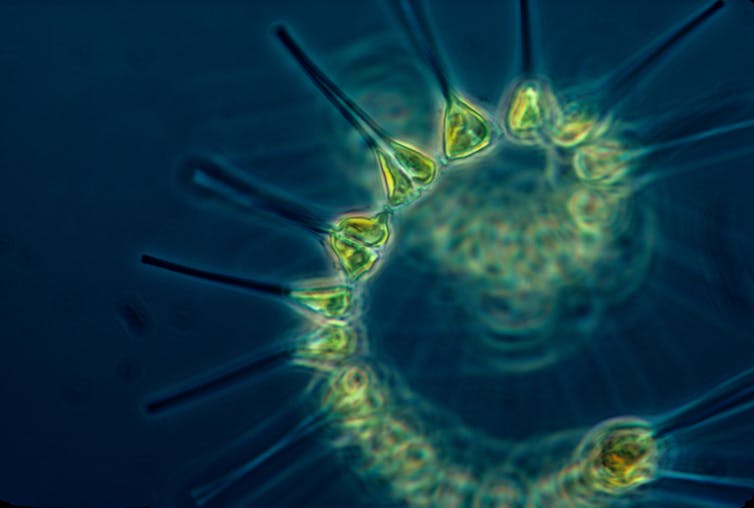

Patricia L. Foster, Indiana University
Possibly the most significant event in the evolution of life on Earth occurred 2.4 billion years ago. That was when the amount of oxygen in the atmosphere and ocean surface waters rapidly increased – setting the stage for a new phase of life on our planet.

Drbogdan, CC BY-SA
Oxygen is produced by photosynthesis, a process that evolved in a type of bacteria called cyanobacteria. Also known – incorrectly – as blue-green algae, you can encounter them today as pond scum.
Cyanobacteria are prokaryotes: simple single-celled organisms. True algae are eukaryotes: more complex, larger organisms. Both perform the same photosynthetic reactions to turn energy from the sun into oxygen and food molecules. The first true algae, as well as other single-celled eukaryotes, arose at least 1.4 billion years ago, but, mysteriously, appear to have remained in the background of life for another 800 million years, at which point they rapidly expanded in number and diversity.
New research by Australian National University earth scientists Nur Gueneli, Jochen Brocks and colleagues confirms the early importance of cyanobacteria in the primordial oceans and provides insights into why it took so long for the true algae to become the base of the food chain.
Billion-year-old biomarkers
Much of our knowledge of evolutionary history comes from the fossil record. Unfortunately, soft-bodied organisms, such as algae, rarely leave fossils. But researchers can recover the biomolecules they contained that are resistant to degradation. Found within ancient sediments, scientists can use these molecular fossils, called biomarkers, to identify what types of organisms were present when the sediments formed.
The new study published in the Proceedings of the National Academy of Science examined extracts of 1.1 billion-year-old sediments from 140 to 200 meters below the surface of a site in Mauritania. This corner in northwest Africa was once covered by an ocean. The researchers didn’t detect any biomarkers indicative of eukaryotes, but did find biomarkers indicating that several types of prokaryotes had been present. So no true algae, but plenty of evidence of photosynthetic bacteria. Of particular interest, they found molecules, called porphyrins, that are the remains of chlorophyll, the molecular basis of photosynthesis.

Lukáš Mižoch, CC BY
Using a clever analysis, the scientists were able to identify with near certainty what organisms were the source of the porphyrins. Nitrogen has two atomic forms, called isotopes, the most common of which, ¹⁴N, has an atomic weight of 14 while the rare isotope, ¹⁵N, has an atomic weight of 15. Although ¹⁴N is preferred, the various enzymes that make chlorophyll also incorporate ¹⁵N in proportions that differ among different classes of photosynthetic organisms. So the ratio of ¹⁴N to ¹⁵N in porphyrin molecules, which have four nitrogen atoms, can indicate what type of organism produced them. By measuring the N-isotope ratios in the porphyrins from the sediments, the scientists were able to trace the molecules to the cyanobacteria.

The Australian National University, CC BY
Not pink, but green
A dramatic picture in the Gueneli paper showed that some of the extracts of the ancient sediments were brilliant pink. News coverage ran with headlines focused on Earth’s “oldest color” being bright pink. But that’s not quite right.
In order to do its chemical job, the porphyrin in chlorophyll contains a magnesium atom that’s responsible for its green color. This is what makes leaves and algae look green. But in these pink extracts, the porphyrin turned out to have a nickel atom instead. Most likely the nickel replaced the magnesium sometime over the billion-plus years the molecules aged in the sediments.
So pink was not the original color of the chlorophyll. It must have been green, as it is in living plants today.
Algae take over from bacteria
The researchers’ major conclusion is that 1.1 billion years ago, photosynthetic bacteria, most likely dominated by cyanobacteria, were the base of the food chain in the ocean. Because the bacteria were small, they would sink slowly and be degraded by other bacteria high in the water column. Little of the precious nutrients they contained would reach the ocean bottom.
Nutrient distribution throughout an ocean depends upon upwelling from the bottom. So most of the ocean would be nutrient-poor, restricting the development of a community of larger organisms.
In addition, cyanobacteria survive better than eukaryotic algae when nutrients are low, which would further restrict the evolution of these larger-celled photosynthetic organisms.

NOAA MESA Project, CC BY
What caused the shift about 650 million years ago from an ocean dominated by cyanobacteria to one dominated by true algae? One of the authors of the PNAS paper, geobiologist Jochen Brocks, points out in a recent review article that this shift occurred a mere 4 million years after the end of a worldwide glaciation, during which the oceans were frozen for more than 50 million years. Then the glaciers melted, probably because rising carbon dioxide levels created a greenhouse effect, heating the Earth. The temperature of the oceans rose rapidly, possibly killing many remaining cyanobacteria. In addition, as the glaciers melted, vast amounts of nutrients would have been swept into the oceans, reversing the competitive disadvantage for the algae, that then were able to evolve and expand.
![]() With the arrival of these larger, rapidly-settling algae as the basis of the food chain, the stage was set for the evolution and expansion of larger eukaryotic consumers.
With the arrival of these larger, rapidly-settling algae as the basis of the food chain, the stage was set for the evolution and expansion of larger eukaryotic consumers.
Patricia L. Foster, Professor Emerita of Biology, Indiana University
This article was originally published on The Conversation. Read the original article.



















